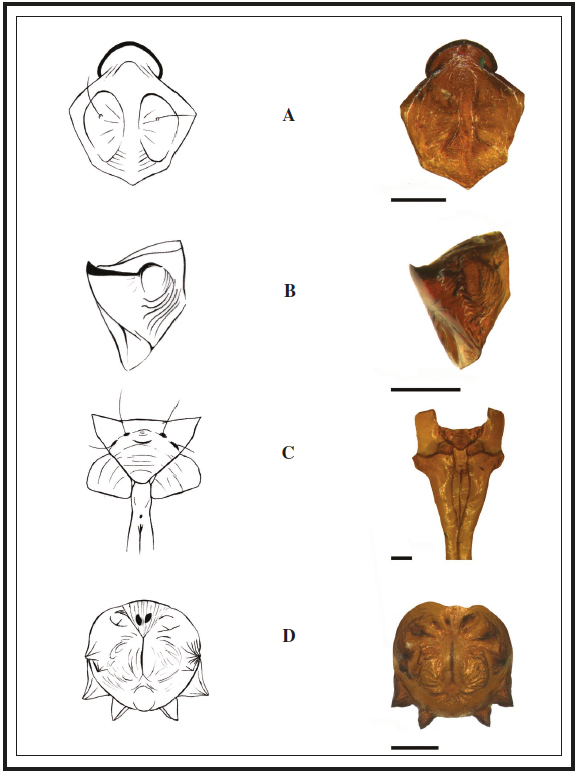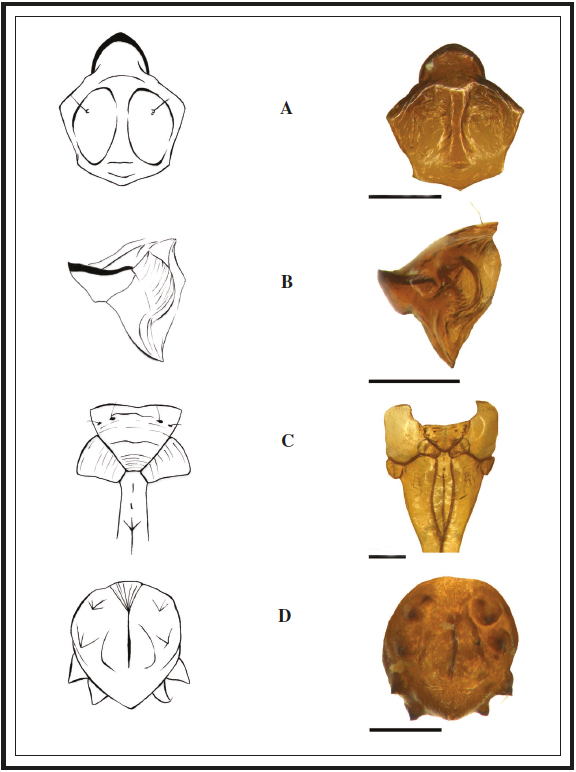

Morphology of pupae of Bembecia fibigeri Laštůvka & Laštůvka, 1994 and Bembecia ibérica Špatenka, 1992 (Lepidoptera: Sesiidae)
Morfología de la pupa de Bembecia fibigeri Laštůvka & Laštůvka, 1994 y Bembecia iberica Špatenka, 1992 (Lepidoptera: Sesiidae)
Morphology of pupae of Bembecia fibigeri Laštůvka & Laštůvka, 1994 and Bembecia ibérica Špatenka, 1992 (Lepidoptera: Sesiidae)
SHILAP Revista de Lepidopterología, vol. 47, no. 186, 2019
Sociedad Hispano-Luso-Americana de Lepidopterología
Received: 18/01/2019
Accepted: 20/03/2019
Published: 30/06/2019
Abstract: Descriptions of the morphology of pupae of two species of clearwing moths, Bembecia fibigeri Laštůvka & Laštůvka, 1994 and B. iberica Špatenka, 1992, are presented for the first time. The main morphological features are described and compared with a closely related species, Bembecia scopigera Scopoli, 1763. Diagnostic features are also illustrated in pictures and line drawings.
Keywords: Lepidoptera, Sesiidae, exuviae, comparative morphology, taxonomy.
Resumen: Se representa, por primera vez, la descrición de la morfología de la pupa de dos especies de sésidos, Bembecia fibigeri Laštůvka & Laštůvka, 1994 y B. iberica Špatenka, 1992. Se describen y comparan las características morfológicas con una especie próxima Bembecia scopigera Scopoli, 1763. Los diagnósticos especiales son también ilustrados en fotografía y dibujo.
Palabras clave: Lepidoptera, Sesiidae, exuvia, morfología comparada, taxonomía.
Introduction
The genus Bembecia Hübner, [1819] containing more than 100 species is one of the most difficult to identify among all Sesiidae (ŠPATENKA et al., 1999). Most of them is described from Asia and in Europe is known 24 species (LAŠTŮVKA, 2013). The taxonomic status of some of them, especially closely related species is unclear and need verification (BARTSCH, 2012). The species of this genus are classified into several groups (ichneumoniformis, scopigera, uroceriformis, megillaeformis, kaszabi and hoffmani) on the basis of their male genitalia morphology. The group scopigera is represented by nine species: Bembecia apyra Le Cerf, 1937, B. fibigeri Laštůvka & Laštůvka, 1994; B. iberica Špatenka, 1992; B. kreuzbergi Špatenka & Bartsch, 2010; B. martensi Gorbunov, 1994; B. pavicevici Tosevski, 1989; B. peterseni Špatenka, 1997; B. priesneri Kallies, Petersen & Riefenstahl, 1989 and B. scopigera (Scopoli, 1763) (PÜHRINGER & KALLIES, 2004). Of these species, only the pupal morphology of Bembecia scopigera has been described thus far, and within the entire genus, the pupal morphology of only 11 species has been described (PATOČKA & TURČANI, 2005; BAKOWSKI & FAJFER, 2019). The main aim of this paper is to study the external morphology of pupae and apply results in subsequent analyses concerning with the taxonomic position of the study species. The pupal stage offers a number of taxonomically diagnostic characters that are potentially useful in phylogenetic analyses (ROUGERIE & ESTRADEL, 2008). One of the aims of the work is also identification of study species already on the basis of pupae or pupal exuviae.
Material and methods
Pupal morphology description is based on the studies of PATOČKA (1987), PATOČKA & TURČANI (2005), BAKOWSKI (2013). The description of the morphology of the Central European pupae of the genus Bembecia has thus far been based primarily on the shape of the labrum, the plate of the head projection blade, clypeus, the lateral depression on the head, and the ventral abdominal end. These morphological features are also used in this paper and are described and illustrated in photographs and line drawings. The pupal exuviae were examined with Nikon SMZ 1000 stereoscope microscope. The photographs were taken with a digital camera AxioCam MRc5 attached to a Lumar V12 stereoscopic microscope, connected to a computer with Axio Vision 4.8 software. The stereoscopic microscope images were made in Laboratory of Electron and Confocal Microscopy (Faculty of Biology, A. Mickiewicz University, AMU, Poznan). The information about biology and distribution of examined species are given by ŠPATENKA et al. (1999) and LAŠTŮVKA & LAŠTŮVKA (2001). The morphological studies were carried out on the basis of analyzes of the pupal exuviae donated by Rolf Bläsius. All material is deposited in the collection of senior author in Department of Systematic Zoology AMU, in Poznan (Poland).
Bembecia fibigeri Laštůvka & Laštůvka, 1994
Material examined: 8 pupal exuviae - 5 ♂♂, 3 ♀♀ (France 1994).
Description: Length and width: 11-17.4 x 2.5-4.7 mm (mean: 14.4 x 3.5 mm). Head projection short and sharply rounded in dorsal view. Frontal depressions large and wrinkled. Frontal setae situated approximately at level of lateral angles of frons in dorsal view (Fig. 1a). Dark margin of head projection robust, blade bent dorsally and pointed in lateral view. Head projection blade without indented ventrally in lateral view. Lateral depression on head wide and rounded ventro-caudad. Frons rises at a slight slope from projection blade (Fig. 1b). Clypeal setae Cl2 close to each other. Distance between setae Cl2 approximately 2 × greater than the distance of Cl2 from Cl1. Labrum almost triangular, slightly rounded on caudal end. Labium tapered only moderately behind its base (Fig. 1c). End of abdomen in ventral view large and rounded. Cremaster approximately equal in length to anal suture. Anal area rather flat (Fig. 1d).

a. Dorsal view of frons, b. Lateral view of frons, c. Labrum and vicinity, d. Ventral abdominal end. Scale bar - 0.5 mm.
Diagnostic features: Head projection short. Labrum almost triangular, slightly rounded on caudal end.
Biology: Univoltine, rarely biennial. The larva lives in the root of Ononis rotundifolia L. and O. fruticosa L.
Distribution: Spain, France.
Bembecia iberica Špatenka, 1992
Material examined: 25 pupal exuviae - 9 ♂♂, 16 ♀♀ (Spain, Portugal, Morocco, 1991-2005)
Description: Length and width: 9.1-15.5 × 2-4 mm (mean: 12.5 × 2.9 mm). Area of head projection blade prolonged and fairly sharply pointed in dorsal view, its length is equal approximately to half of its width. Frontal setae situated approximately at level or slightly behind level of lateral angles of frons in dorsal view. Frontal depressions large and wrinkled (Fig. 2a). Dark margin of head projection robust, blade bent dorsally and pointed in lateral view. Frons rises at a slight slope from head projection blade. Head projection blade distinctly indented ventrally in lateral view. Lateral depression on head relatively narrow and concave caudoventrally (Fig. 2b). Distance between clypeal setae Cl2 approximately 3 × greater than the distance of Cl2 from Cl1. Labrum truncate on caudal end. Labium tapered only moderately behind its base (Fig. 2c). End of abdomen in ventral view elongated and pointed. Anal suture slightly longer than cremaster. Anal area flat (Fig. 2d).

a. Dorsal view of frons, b. Lateral view of frons, c. Labrum and vicinity, d. Ventral abdominal end. Scale bar - 0.5 mm.
Diagnostic features: Head projection blade distinctly indented ventrally in lateral view. Labrum truncate on caudal end.
Biology: Univoltine. Larva feed in roots of plants Lotus sp., Hippocrepis sp., Melitolus sp., Anthyllis vulneraria L.
Distribution: Spain, Portugal, France, Italy, Morocco.
Discussion
According to PATOČKA & TURČANI (2005), the diagnostic features of Bembecia pupae are a proboscis that does not reach the mesothoracic legs or apices of the antennae, a rounded head projection blade and a postclypeus without projections. The species Bembecia fibigeri, B. iberica and a closely related species B. scopigera can be separated by comparing their pupal morphology. Head projection in B. iberica and B. scopigera is elongated and pointed. In B. fibigeri head projection is short and rounded. The compared species differ also in the shape of labrum, which is truncate on caudal end in B. iberica whereas it is rounded on caudal end in B. fibigeri and B. scopigera. The compared species differ in the arrangement of the clypeal setae. In B. fibigeri distance between clypeal setae Cl2 is approximately 2 x greater than distance of Cl2 from Cl1, in B. iberica and B. scopigera from 3 to 3.5 x greater than distance of Cl2 from Cl1. The shape of the cremaster of the study species is also different. In B. fibigeri, it is large and rounded, in B. iberica and B. scopigera it is more slender and pointed. However, it seems this feature is variable and changes with sex. In males, the abdomen is more slender, which is why the end of the abdomen of pupae is often more elongated and pointed. In females, the abdomen is wider; therefore the end of the abdomen of pupae is generally wider and more rounded.
In conlusion, identification of Bembecia pupae to the species level is not easy and can be problematic. For this reason the knowledge of host plant from which the larva, pupa or exuvium were collected is important diagnostic information.
We would like to stress that we are aware that it is not possible to classify insect groups only on the basis of pupal morphology, particularly when working with species from a single geographical region. Unfortunately, the biology of many of Bembecia species is still unknown.
We only offer suggestions and provide recommendations for taxonomists to consider pupal morphology in the future placement of the species described in this paper.
Acknowledgements
We would like to express our sincere thanks to Rolf Bläsius (Germany) for donation of the exuviae material and Tara Massad (USA) for carefully checking the English of an advanced draft.
BIBLIOGRAPHY
BARTSCH, D., 2012.– Revision of types of several species of Bembecia Hübner, 1819 from northern Africa and southwestern Europe (Sesiidae).– Nota lepidopterologica, 35(2): 125-133.
BAKOWSKI, M., 2013.– The Sesiidae (Lepidoptera) of Poland: 277 pp. Kontekst Publishing House, Poznan.
BAKOWSKI, M. & FAJFER, D., 2019.– Morphology of pupae of five species of the genus Bembecia – group ichneumoniformis (Lepidoptera, Sesiidae).– Zootaxa, in press
LAŠTŮVKA, Z., 2013.– Sesiidae.– In O. KARSHOLT & E. J. VAN NIEUKERKEN (eds): Fauna Europaea: Lepidoptera, Moths. Fauna Europaea version 2017.06. Available from https://fauna-eu.org (accessed 5 December 2018).
LAŠTŮVKA, Z. & LAŠTŮVKA, A., 2001.– The Sesiidae of Europe: 245 pp. Apollo Books, Stenstrup.
PATOČKA, J., 1987.– Die Puppen der mitteleuropäischen Vertreter der Familie Sesiidae (Lepidoptera).– Vestnik Geskoslovenské spolegnosti zoologické, 51: 11-38.
PATOČKA, J. & TURČANI, M., 2005.– Lepidoptera Pupae: Central European Species: 863 pp., 271 plates. Apollo Books, Stenstrup.
PÜHRINGER, F. & KALLIES, A., 2004.– Provisional checklist of the Sesiidae of the world (Lepidoptera: Ditrysia).– Mitteilungen der Entomologischen Arbeitsgemeinschaft Salzkammergut, 4: 1-85.
ROUGERIE, R. & ESTRADEL, Y., 2008.– Morphology of the preimaginal stages of the African emperor moth Bunaeopsis licharbas (Maassen and Weyding): phylogenetically informative characters within the Saturniinae (Lepidoptera: Saturniidae).– Journal of Morphology,269(2): 207-32.
ŠPATENKA, K., GORBUNOV, O., LAŠTŮVKA, Z., TOŠEVSKI, I. & ARITA, Y., 1999.– Sesiidae, Clearwing Moths.– In C. M. NAUMANN (ed.). Handbook of Palaearctic Macrolepidoptera, 1: 569 pp. Gem Publishing Company, Wallingford.
Author notes
*Autor para la correspondencia / Corresponding author. E-mail: bakowski@amu.edu.pl